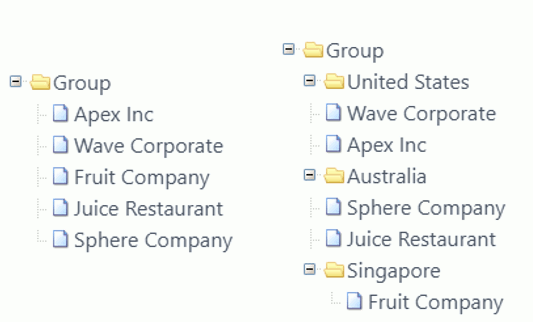As businesses grow and expand, they often find themselves managing multiple companies, subsidiaries, or business units. This structure, while beneficial for scaling operations and reducing risk, introduces a significant challenge: financial consolidation. This process involves combining financial data from multiple legal entities into a single, unified view for accurate financial reporting and analysis.
BrizoSystem is designed to make this process seamless and efficient, offering a range of features that simplify multi-company management, including its powerful Virtual Group feature. In this blog, we’ll explore how BrizoSystem handles consolidation and why Virtual Groups are a game-changer for businesses with complex structures.
Understanding Financial Consolidation in BrizoSystem
At its core, BrizoSystem is built to handle financial consolidation across multiple companies. It offers a comprehensive suite of features that address the unique challenges of group accounting, including:
1. Common Chart of Accounts (CCOA)
One of the biggest challenges in consolidation is dealing with different charts of accounts across subsidiaries. BrizoSystem solves this with a Common Chart of Accounts (CCOA), allowing you to standardize account mappings across all your entities. This ensures consistent financial reporting and eliminates the need for manual data adjustments.
For example, if one company uses “Sales Revenue” and another uses “Product Sales,” these can be mapped to a single CCOA category, providing a clear, consolidated view of group revenue.
2. Multi-Currency Management
BrizoSystem seamlessly handles multi-currency consolidations, applying exchange rates automatically to ensure accurate group-level financials. This is critical for businesses with subsidiaries in different countries or regions.
For instance, if a parent company in Singapore has subsidiaries in Australia, the UK, and the US, BrizoSystem can consolidate financials in SGD, converting AUD, GBP, and USD at the appropriate rates, without the need for manual adjustments.
3. Intercompany Eliminations
Intercompany transactions, such as loans, sales, and management fees, can significantly distort group financials if not properly eliminated. BrizoSystem offers flexible elimination methods, including both Group Level and Subsidiary Level input, allowing you to choose the method that best fits your consolidation strategy.
For example, you can eliminate intercompany sales to avoid double counting revenue or remove intercompany loans to prevent inflated asset values.
4. Drill-Down Reporting
Transparency is critical in consolidated reporting. BrizoSystem allows users to drill down from consolidated figures to the individual transactions that make up those numbers, providing unparalleled visibility into group financial performance.
Introducing Virtual Groups: Beyond Traditional Company Structures
While most consolidation tools are built around legal structures, BrizoSystem goes a step further by introducing Virtual Groups. This feature allows you to create custom groupings based on factors other than ownership, giving you a more flexible view of your business.
What Are Virtual Groups?
Virtual Groups let you consolidate entities based on factors like geography, business function, or market segment, rather than just legal ownership. This is ideal for businesses with complex, diversified operations or those looking to understand their performance from multiple perspectives.
Advantages of Virtual Groups in BrizoSystem
1. Geographic or Regional Reporting
If your business operates across multiple regions, you can create Virtual Groups based on geography. For example, you might have separate legal entities in Australia, New Zealand, and Singapore, but want to see consolidated financials for the APAC region. With Virtual Groups, this is straightforward.
2. Functional or Product Line Reporting
If your business has different product lines or services, you can create Virtual Groups to monitor their financial performance independently. For example, a technology company might group its software, hardware, and services businesses separately to assess profitability.
3. Strategic Business Units
If your business is structured around different strategic units or divisions, Virtual Groups allow you to assess each unit’s contribution to the overall business without being restricted by legal structures.
4. Flexible Financial Analysis
Virtual Groups enable a more nuanced understanding of your business. You can quickly compare performance across regions, business units, or product lines, helping you make more informed strategic decisions.
5. Simplified Management and Reporting
Virtual Groups make it easier to generate financial statements, KPI reports, and management dashboards for specific business segments, without having to manually aggregate data from different entities.
Practical Example: Virtual Group in Action
Imagine a multinational company with the following structure:
- Parent Company (SG)
- AU Subsidiary (Manufacturing)
- NZ Subsidiary (Sales and Distribution)
- UK Subsidiary (R&D)
- US Subsidiary (Sales and Marketing)
With Virtual Groups, this company can create multiple perspectives for financial analysis:
- Geographic View (e.g., APAC, EMEA, Americas)
- Business Function View (e.g., Manufacturing, Sales, R&D)
- Strategic Unit View (e.g., High-Growth Markets, Mature Markets)
This flexibility enables better financial planning, performance tracking, and strategic decision-making.
Conclusion: Why BrizoSystem is the Ideal Solution for Multi-Company Management
Managing multiple companies is challenging, but it doesn’t have to be chaotic. With BrizoSystem’s comprehensive consolidation tools and innovative Virtual Group feature, you can streamline your financial reporting, eliminate manual work, and gain a clearer view of your group’s performance.
If you’re tired of juggling spreadsheets and struggling with complex group structures, it’s time to see what BrizoSystem can do for your business.
✅ Ready to Simplify Multi-Company Management?
✅ Watch a Demo
✅ Start Your Free Trial Today

